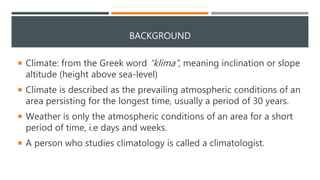Basic climatology
- 1. CLIMATOLOGY PHOTO BY OLYMPUS SP590UZ, PIXABAY / CC BY 2.0
- 3. BACKGROUND  Climate: from the Greek word “klima”, meaning inclination or slope altitude (height above sea-level)  Climate is described as the prevailing atmospheric conditions of an area persisting for the longest time, usually a period of 30 years.  Weather is only the atmospheric conditions of an area for a short period of time, i.e days and weeks.  A person who studies climatology is called a climatologist.
- 4. ELEMENTS OF CLIMATE. This Photo by Unknown Author is licensed under CC BY-SA ÔÇ° Temperature ÔÇ° Precipitation ÔÇ° Wind ÔÇ° Humidity
- 5. FACTORS AFFECTING CLIMATE ÔÇ° Distance from the equator ÔÇ° Distance from the sea ÔÇ° Ocean currents ÔÇ° Altitude This Photo by Unknown Author is licensed under CC BY-NC-ND
- 6. INDICES LOOK IN THE SLIDE NOTES BELOW FOR TOPICS TO CONSIDER TALKING ABOUT PHOTO BY NOAA / PUBLIC DOMAIN
- 7. WORKS CITED ÔÇ° Denesia, M. (2016) Climatology. Available online from /MerlynH/climatology-65434880 (Accessed 02 September 2018) ÔÇ° Kumar, R. (2016) Climatology elements and factors. Available online from /RohitKumar79/1-climatology-factors-and-elements (Accessed 02 September 2018) ÔÇ° Hadi, G. (2013) Climatology. Available online from /GhassanHadi/climatology-29438759 (Accessed 02 September 2018) ÔÇ° Seedat, T. (2015) Climatology. Available online from /TasneemSeedat/climatology-53393073 (Accessed 03 September 2018) ÔÇ° Patel, P. (2016) Climatology. Available online from /PPatel3/climatology-58333533 (03 September 2018)
Editor's Notes
- #7: Consider talking about: El Niño–Southern Oscillation Madden–Julian oscillation North Atlantic oscillation (NAO) Northern Annular Mode (NAM) or Arctic oscillation (AO) Northern Pacific (NP) Index Pacific decadal oscillation (PDO) Interdecadal Pacific oscillation (IPO)







